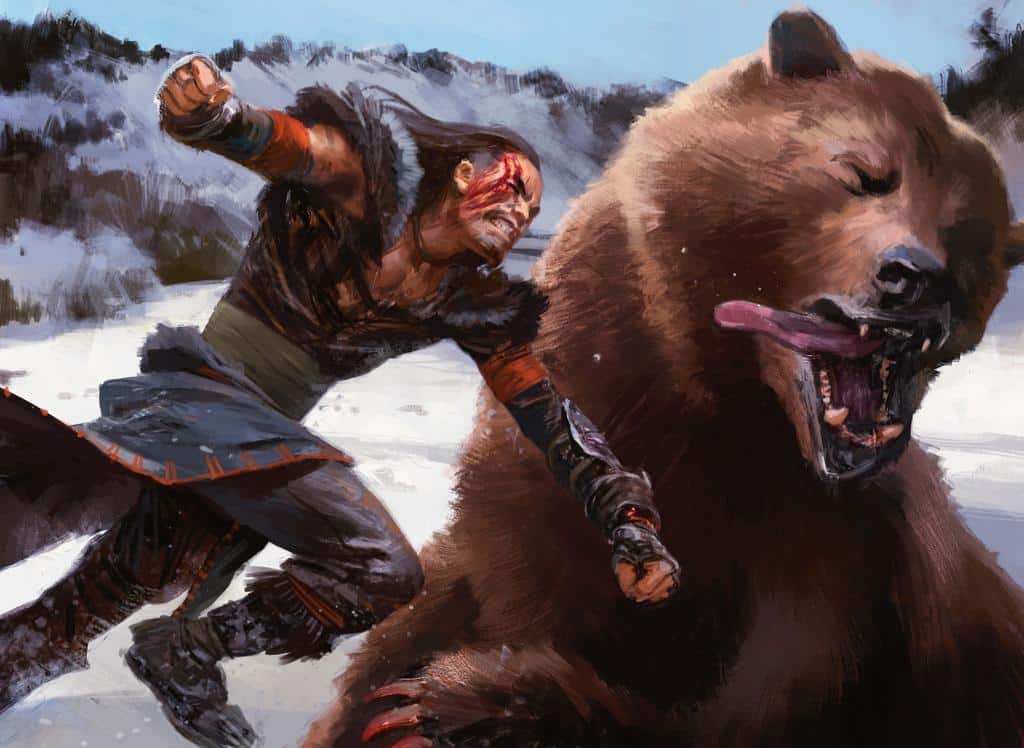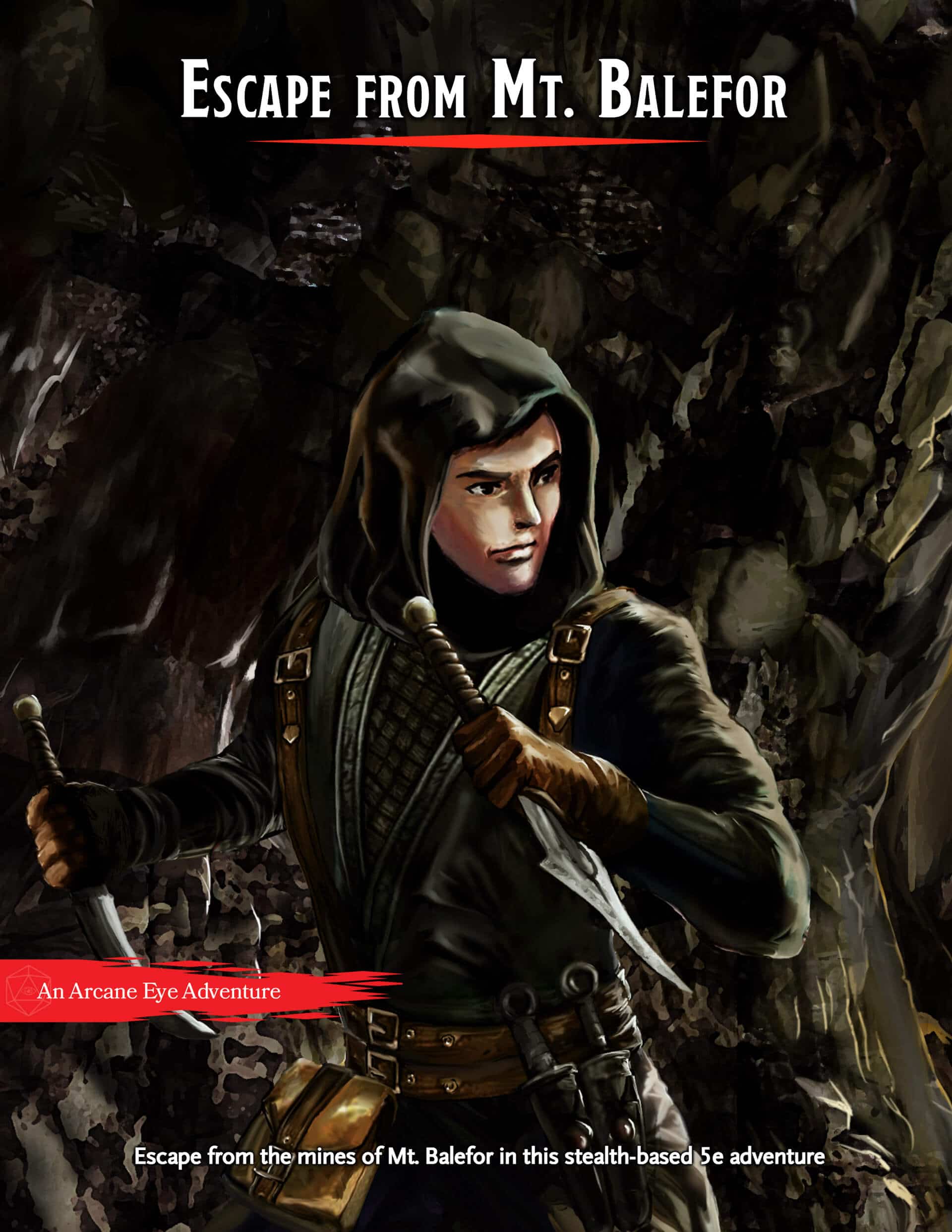Unarmed Strike 5e
Published on May 30, 2023, Last modified on December 8th, 2023
Unleash the power of unarmed combat in D&D with this comprehensive guide on unarmed strikes in 5e.

Wesley Burt - ©Wizards of the Coast - Savage Punch
Table of Contents
Unarmed Strikes in 5E
D&D offers a wide variety of methods for “aggressive negotiations.” Some adventurers often may choose to wield legendary weapons while others cast mighty spells as their favored methods of monster dispatch. But have you ever wanted to just punch an opponent in the face?
Amidst the clamor of clashing swords and incantations, the humble unarmed strike often goes unnoticed. This article aims to shine a spotlight on this underappreciated combat choice, exploring its mechanics, potential, and techniques to employ it effectively.
What is an Unarmed Strike in 5E?
At its core, an unarmed strike in D&D 5E is an attack made with any part of your body – your fists, elbows, knees, feet, or even head and tail for certain races. It doesn’t require a weapon, making it a versatile option in diverse scenarios.
The basic unarmed strike deals a modest 1 point of bludgeoning damage, to which you add your Strength modifier. This is what the Basic Rules have to say about unarmed strikes:
Instead of using a weapon to make a melee weapon attack, you can use an unarmed strike: a punch, kick, head-butt, or similar forceful blow (none of which count as weapons). On a hit, an unarmed strike deals bludgeoning damage equal to 1 + your Strength modifier. You are proficient with your unarmed strikes.
The unarmed strike is unique in that it’s not categorized as a weapon per se, but as a melee attack. This distinction can affect interactions with various game mechanics, including spells, feats, and class abilities, some of which we’ll delve into later.
Making Unarmed Strikes in D&D
Seeing as everyone is automatically proficient with unarmed strikes, you would make an attack roll by rolling a d20, adding your Strength modifier, and then adding your proficiency bonus. For example, if our 5th-level barbarian with 18 Strength punches a bandit leader in the face, this is what it would look like:
Attack Roll: d20 + 4 (Strength modifier) + 3 (proficiency bonus)
Unarmed Strike Damage 5e
When you hit, you deal 1 + Strength modifier damage. That is, unless you have a class feature that says otherwise. For the example above of our 5th-level barbarian with 18 Strength, you’d deal 5 damage when you hit:
Damage: 1 + 4 (Strength modifier) = 5
There are ways of increasing unarmed strike damage in 5e. The best ways to do so are the following:
- Increase Strength: Increasing your character’s Strength score is one of the most straightforward ways to increase unarmed strike damage in D&D 5e. Since unarmed strikes are typically based on the Strength score, any increases to this stat will result in additional damage. This can be achieved by leveling up, using Ability Score Improvements, or through certain magical items like the Belt of Giant Strength.
- Monk’s Martial Arts: A defining feature of the monk class in D&D 5e is their Martial Arts ability. This ability allows monks to use their Dexterity modifier for attack and damage rolls with unarmed strikes, and the damage die for these strikes increases as they level up. At higher levels, a Monk’s unarmed strike can do up to 1d10 per hit.
- Unarmed Fighting Style: This Fighting Style can step up the damage of unarmed strikes to 1d6 or 1d8 if you’re not wielding anything in your offhand.
- Natural Weapons: Some races have natural weapons that supplement your unarmed strikes. The best natural weapons out there are either the lizardfolk’s Bite which do 1d6 and can provide temp hp or the minotaur’s Horns which deal 1d6 and can be used as a bonus action as a part of Goring Rush.
Unarmed Strike Rule Interactions
For something as seemingly simple as punching someone, there are a lot of interactions with D&D 5e’s combat system:
Paladin Smite
Even though an unarmed strike is technically a melee weapon attack, it was confirmed on D&D Beyond’s Sage Advice Compendium to not be intended to work with the Paladin’s Divine Smite.
Offhand Attacks
You can only use your bonus action for an offhand attack when you make an attack with a weapon with the light property and are holding a second weapon with the light property. This means you cannot use your bonus action to offhand attack with an unarmed strike unless you’re a monk (discussed below).
Critical Hits
Unless you have a feature that makes unarmed strikes use a damage dice, when you crit with an unarmed strike, you still deal 1 + your Strength modifier. While the damage may be disappointing, you still automatically hit your target, which is an upside.
Which Builds Work Best With Unarmed Strikes
Certain classes and subclasses in D&D 5E can take the simple unarmed strike to new levels, unlocking a host of potent and dynamic combat options.
Monk
The monk class has an intrinsic synergy with unarmed strikes. The Martial Arts class feature allows monks to use their Dexterity modifier instead of Strength for unarmed strikes. They also can make an unarmed strike as a bonus action after their attack, allowing them to up their action economy and damage output. They can even spend ki points to use Flurry of Blows to make two unarmed strikes as a bonus action.
Most importantly, their unarmed strikes damage scales with the monk’s level, providing a significant boost to their damage output. At higher levels, Ki-Empowered Strikes make a monk’s unarmed strikes count as magical for the purpose of overcoming resistance and immunity to nonmagical attacks.
Barbarian
Barbarians, though traditionally weapon-oriented, can become formidable unarmed combatants. Not only do they love to get in close, but their Rage feature also grants a bonus to melee damage rolls, which encompasses unarmed strikes. If you want your barbarian to punch above their weight class, consider picking up the Tavern Brawler feat. This feat slightly increases the damage done by allowing you roll a d4 + your Strength instead of simply dealing 1 damage + Strength. It also allows you to try to grapple creatures as a bonus action after you hit them with an unarmed strike. This, combined with the Grappler feat and advantage on Strength checks because of Rage, can make you a formidable presence on the battlefield.
If you’re looking to go all in on unarmed strikes, the Fighting Initiate feat is a must because it allows you to pick up Unarmed Fighting and use a d6 (or even a d8 if you’re not using a shield) on your unarmed strikes. This feat also lets you deal 1d4 bludgeoning damage to any creature grappled by you, making it a perfect combination with Tavern Brawler and Grappler.
Fighter
Similar to barbarians, fighters can make use of Grappler and Tavern Brawler to create a somewhat viable unarmed strike build. Fighters innately get access to the Unarmed Fighting through their Fighting Styles and they get a lot of feats that they can use to pick up Tavern Brawler, Grappler, and even Crusher.
Unarmed Strike 5e FAQs
Can you add your Strength modifier to the damage of an unarmed strike in D&D 5E?
Yes, you can. In D&D 5E, when you make an unarmed strike, you add your Strength modifier to both the attack roll and the damage roll.
Can a Monk use Dexterity for unarmed strikes?
Yes, a monk can use Dexterity instead of Strength for unarmed strikes thanks to their Martial Arts class feature. This feature also allows them to roll a d4 in place of the normal damage of their unarmed strike, and this die changes as they gain monk levels.
Are unarmed strikes considered melee weapon attacks?
Yes, unarmed strikes are considered melee weapon attacks, but they are not considered weapons. This means that they can be used for features that require a melee weapon attack but not for features that require a weapon, like the paladin's Divine Smite.
Can you make an unarmed strike as an opportunity attack?
Yes, you can. When a hostile creature provokes an opportunity attack from you, you can make an unarmed strike against the creature.
Do unarmed strikes count as magical for overcoming resistance and immunity?
Not normally, but the Monk class has a feature called Ki-Empowered Strikes that allows their unarmed strikes to be counted as magical for the purpose of overcoming resistance and immunity to nonmagical attacks and damage.
Does the two-weapon fighting work with unarmed strikes?
No, the two-weapon fighting does not work with unarmed strikes. This is because unarmed strikes are not considered to be weapons in D&D 5E. They are melee weapon attacks, but not weapons themselves.
Can you use unarmed strikes while holding a weapon or shield?
Yes, you can. Unarmed strikes can be made with any part of the body, so even if your hands are occupied with a weapon or a shield, you can still make an unarmed strike.
Which feats are best for unarmed strikes?
Tavern Brawler, Grappler, and Crusher are the best feats to take when you want to optimize your unarmed strike build.
Put Your Dukes Up
The beauty of D&D lies in its sheer range of options and the room it provides for creativity. Unarmed strikes in D&D 5E may seem less glamorous compared to other weapon choices, but they hold their own unique appeal and potential. The true value of unarmed strikes lies in their versatility, their ability to adapt to unexpected circumstances, and the way they can influence character design and roleplay.
